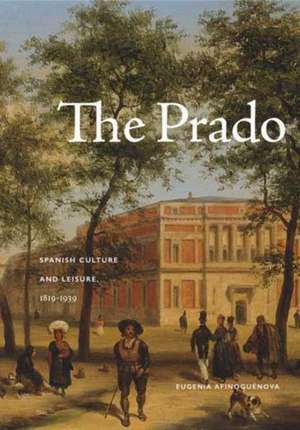The Prado – Spanish Culture and Leisure, 1819–1939
Autor Eugenia Afinoguénovaen Limba Engleză Hardback – 26 oct 2017
Rather than assume that visitors agreed about how to interpret the museum, Afinogu nova approaches the history of the Prado as a debate about culture and leisure. Just like those crossing the museum's threshold, who did not always trace a firm line between what they could see or do inside the building and outside on the Paseo del Prado, the participants in this debate--journalists, politicians, museum directors, art critics--considered museum-going to be part of a broader discussion concerning citizenship and voting rights, the rise of Madrid to the status of a modern capital, and the growing gap between town and country.
Based on extensive archival research on the museum's displays and policies as well as the attitudes of visitors and city-dwellers, The Prado unfolds the museum's many political and propagandistic roles and examines its complicated history as a monument to the tension between culture and leisure. Art historians and scholars of museum studies and visual and leisure culture will find this foundational study of the Prado invaluable.
Preț: 515.60 lei
Preț vechi: 853.89 lei
-40% Nou
Puncte Express: 773
Preț estimativ în valută:
98.67€ • 102.39$ • 82.47£
98.67€ • 102.39$ • 82.47£
Carte indisponibilă temporar
Doresc să fiu notificat când acest titlu va fi disponibil:
Se trimite...
Preluare comenzi: 021 569.72.76
Specificații
ISBN-13: 9780271078571
ISBN-10: 027107857X
Pagini: 312
Dimensiuni: 189 x 258 x 32 mm
Greutate: 0.77 kg
Editura: Penn State University
ISBN-10: 027107857X
Pagini: 312
Dimensiuni: 189 x 258 x 32 mm
Greutate: 0.77 kg
Editura: Penn State University
Notă biografică
Eugenia Afinoguénova is Professor of Spanish and Spanish Culture at Marquette University. She is the co-editor of Spain Is (Still) Different: Tourism and Discourse in Spanish Identity and the author of El idiota superviviente: Artes y letras españolas frente a la "muerte del hombre," 1969-1990.
Descriere
Explores the history of Spain's most iconic art museum. Highlights the political history of the museum's relation to the monarchy, the church, and the liberal nation state, as well as its role as an extension of Madrid's social center, the Prado Promenade.
